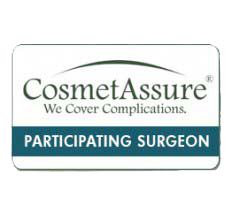What is breast augmentation?
Breast augmentation is increasing the size of a normal breast, usually with a saline or silicone gel breast implant. This is accomplished by placement of the implant above or below the pectoralis muscle through an incision usually either in the fold under the breast, around the lower half of the areola, or in the axilla. Placement of the implant under the muscle is preferred in women with little breast tissue, is associated with a lower capsular contracture rate, and makes mammography slightly more accurate, however, submuscular placement can cause implant movement with more physical activity. Your plastic surgeon
can further discuss the pros and cons of each option during consultation.
What is the difference between saline and silicone gel implants?
Both saline and silicone implants are composed of an outer silicone shell and come in varying shapes and sizes. In the event of rupture, the damage is almost immediately noticeable with saline implants as the saline is absorbed by your tissue, as opposed to silicone implants which make rupture detection more difficult. Silicone gel implants have a more natural feel and appearance, are less prone to rupture and rippline and have been proven safe by the FDA. According to the FDA, you must be 22 years of age to receive silicone implants and 18 years of age for saline implants. Silicone gel implants are more expensive than saline.
What is breast reconstruction?
Breast reconstruction is a physically and emotionally rewarding procedure for women who have lost a breast, usually do to cancer, that is aimed at restoring a woman’s sense of normalcy and breast symmetry in clothing without the need for an external breast prosthesis.
Who is a candidate for breast reconstruction?
Most women are candidates for some type of breast reconstruction procedure but there are a number of factors to consider and determining which procedure is most appropriate for each woman. These factors include the stage of breast cancer, the need for radiation therapy, overall health status and the amount of recovery time a woman will allow herself.
What should I expect after breast reconstruction?
There are several plastic surgery techniques pain at restoring a breast to a near normal size and shape after mastectomy. Each one of these techniques will achieve a slightly different result. A woman can expect that the reconstructed breast will not have the same sensation and feel as her original breast. There will be visible incisions of varying size or shape from either the mastectomy and/or the reconstruction. Some reconstruction techniques believe scars from the incision lines at a donor site separate from the breast such as the abdomen, back or buttocks.
What should I expect in my consultation with a plastic surgeon?
Be prepared to discuss your goals and expectations of reconstruction. Your plastic surgeon will ask you general medical questions including any medical conditions, prior surgeries, current medications and drug allergies and the use of tobacco, alcohol, drugs or herbal supplements. Your surgeon will inform you of your available breast reconstruction options and the associated risks and potential complications. Your surgeon will perform an examination and take photographs for your medical record. Finally, you and your surgeon will decide on a treatment course and discuss the likely outcomes including what to expect before and after surgery, the expected recovery and any risks or potential complications.
What are the options for breast reconstruction?
Your reconstruction can be performed in either an immediate or delayed setting. If immediate, your reconstruction will be performed in the same setting as you are mastectomy. If delayed, the reconstruction can be performed weeks to years following the mastectomy. Basically, there are 3 forms of reconstruction: Implant based reconstruction; autologous reconstruction; and a combination of autologous and implant based reconstruction. Implant based reconstruction is usually a 2-stage technique in which a tissue expander is placed during the first operation and the tissue expander was replaced by a permanent implant with a second operation. Autologous reconstruction involves using tissue from another area of your body, usually your back or abdomen, to replace the skin and tissue loss by the mastectomy. An implant is used in conjunction with autologous reconstruction if additional volume is required above and beyond that which is supplied by the tissue flap.
How much does breast reconstruction cost?
The cost for breast reconstruction can vary widely but is always a factor in any surgery. Once a diagnosis of breast cancer is made or a woman is found to be at a significant increased risk for developing breast cancer, breast reconstruction following mastectomy and any subsequent revisions related to the reconstruction are almost always covered by health insurance.
For more information on breast surgery, you can schedule a consultation with Dr. Nicholas Tarola by calling 615-624-8914 or go to www.tarolaplasticsurgery.com.



